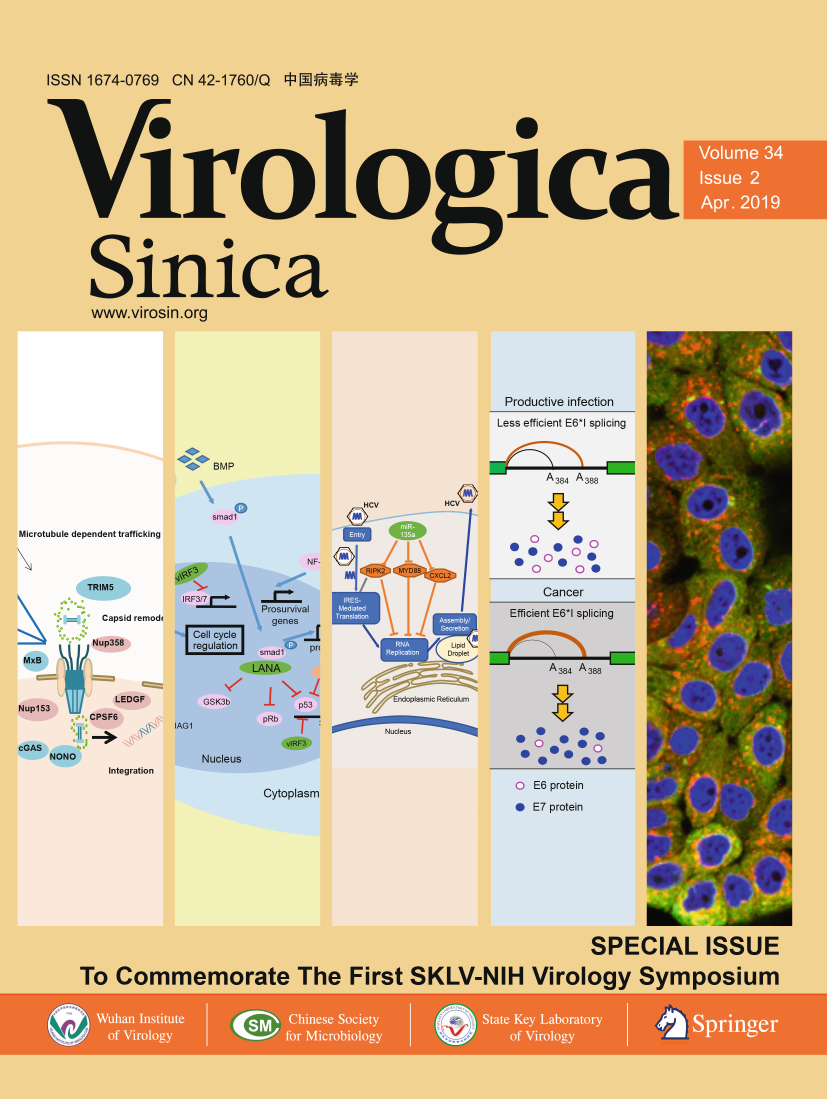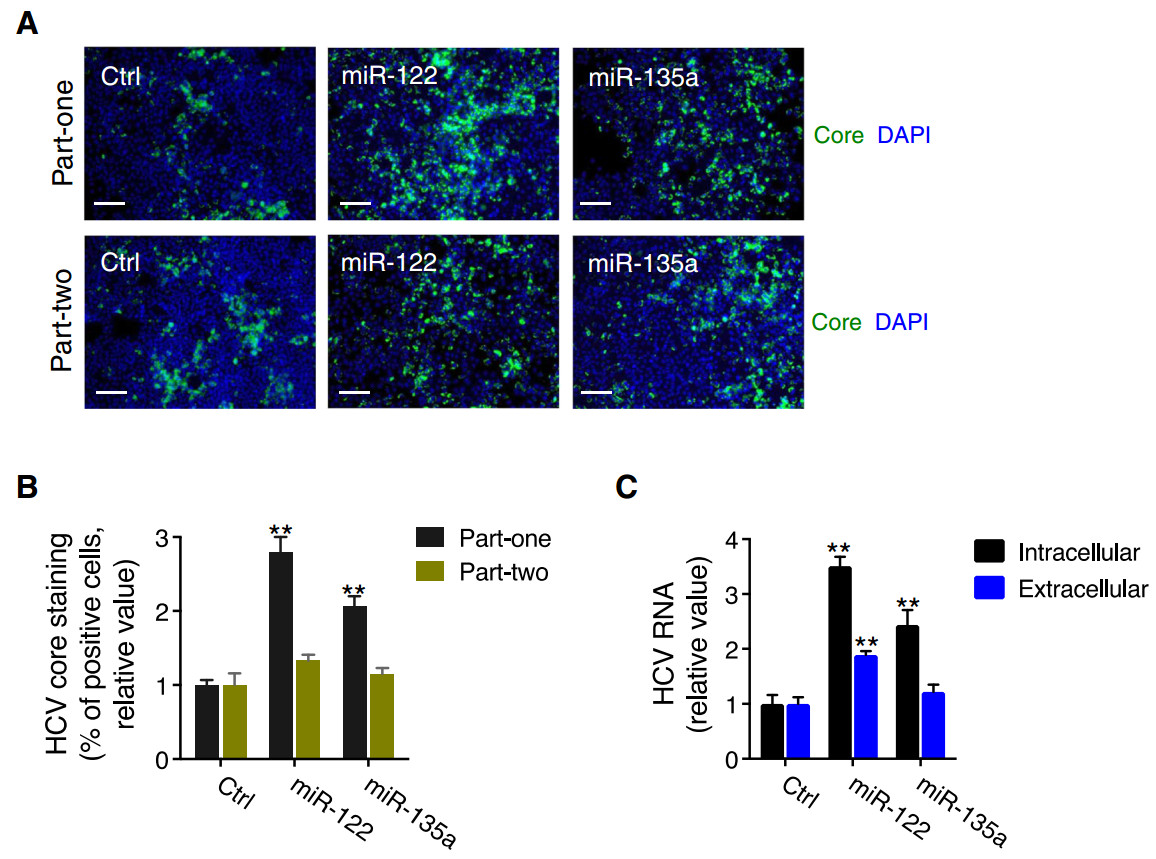-
Akira S, Takeda K. 2004. Toll-like receptor signalling. Nat Rev Immunol, 4:499-511
doi: 10.1038/nri1391
-
Bandiera S, Pfeffer S, Baumert TF, Zeisel MB. 2015. miR-122-a key factor and therapeutic target in liver disease. J Hepatol, 62:448-457
doi: 10.1016/j.jhep.2014.10.004
-
Bandyopadhyay S, Friedman RC, Marquez RT, Keck K, Kong B, Icardi MS, Brown KE, Burge CB, Schmidt WN, Wang Y, McCaffrey AP. 2011. Hepatitis C virus infection and hepatic stellate cell activation downregulate miR-29: miR-29 overexpression reduces hepatitis C viral abundance in culture. J Infect Dis, 203:1753-1762
doi: 10.1093/infdis/jir186
-
Bartel DP. 2009. MicroRNAs: target recognition and regulatory functions. Cell, 136:215-233
doi: 10.1016/j.cell.2009.01.002
-
Bogerd HP, Skalsky RL, Kennedy EM, Furuse Y, Whisnant AW, Flores O, Schultz KL, Putnam N, Barrows NJ, Sherry B, Scholle F, Garcia-Blanco MA, Griffin DE, Cullen BR. 2014. Replication of many human viruses is refractory to inhibition by endogenous cellular microRNAs. J Virol, 88:8065-8076
doi: 10.1128/JVI.00985-14
-
Cullen BR. 2013. How do viruses avoid inhibition by endogenous cellular microRNAs? PLoS Pathog 9:e1003694
doi: 10.1371/journal.ppat.1003694
-
El-Serag HB, Kanwal F, Richardson P, Kramer J. 2016. Risk of hepatocellular carcinoma after sustained virological response in Veterans with hepatitis C virus infection. Hepatology, 64:130-137
doi: 10.1002/hep.v64.1
-
Fabian MR, Sonenberg N, Filipowicz W. 2010. Regulation of mRNA translation and stability by microRNAs. Annu Rev Biochem, 79:351-379
doi: 10.1146/annurev-biochem-060308-103103
-
Gottwein JM, Scheel TK, Jensen TB, Lademann JB, Prentoe JC, Knudsen ML, Hoegh AM, Bukh J. 2009. Development and characterization of hepatitis C virus genotype 1-7 cell culture systems: role of CD81 and scavenger receptor class B type Ⅰ and effect of antiviral drugs. Hepatology, 49:364-377
doi: 10.1002/hep.22673
-
Guo H, Ingolia NT, Weissman JS, Bartel DP. 2010. Mammalian microRNAs predominantly act to decrease target mRNA levels. Nature, 466:835-840
doi: 10.1038/nature09267
-
Hou W, Tian Q, Zheng J, Bonkovsky HL. 2010. MicroRNA-196 represses Bach1 protein and hepatitis C virus gene expression in human hepatoma cells expressing hepatitis C viral proteins. Hepatology, 51:1494-1504
doi: 10.1002/hep.23401
-
Hou J, Lin L, Zhou W, Wang Z, Ding G, Dong Q, Qin L, Wu X, Zheng Y, Yang Y, Tian W, Zhang Q, Wang C, Zhang Q, Zhuang SM, Zheng L, Liang A, Tao W, Cao X. 2011. Identification of miRNomes in human liver and hepatocellular carcinoma reveals miR-199a/b-3p as therapeutic target for hepatocellular carcinoma. Cancer Cell, 19:232-243
doi: 10.1016/j.ccr.2011.01.001
-
Jopling CL, Yi M, Lancaster AM, Lemon SM, Sarnow P. 2005. Modulation of hepatitis C virus RNA abundance by a liver-specific MicroRNA. Science, 309:1577-1581
doi: 10.1126/science.1113329
-
Kato T, Matsumura T, Heller T, Saito S, Sapp RK, Murthy K, Wakita T, Liang TJ. 2007. Production of infectious hepatitis C virus of various genotypes in cell cultures. J Virol, 81:4405-4411
doi: 10.1128/JVI.02334-06
-
Lavillette D, Tarr AW, Voisset C, Donot P, Bartosch B, Bain C, Patel AH, Dubuisson J, Ball JK, Cosset FL. 2005. Characterization of host-range and cell entry properties of the major genotypes and subtypes of hepatitis C virus. Hepatology, 41:265-274
doi: 10.1002/(ISSN)1527-3350
-
Lecellier CH, Dunoyer P, Arar K, Lehmann-Che J, Eyquem S, Himber C, Saib A, Voinnet O. 2005. A cellular microRNA mediates antiviral defense in human cells. Science, 308:557-560
doi: 10.1126/science.1108784
-
Li Q, Brass AL, Ng A, Hu Z, Xavier RJ, Liang TJ, Elledge SJ. 2009. A genome-wide genetic screen for host factors required for hepatitis C virus propagation. Proc Natl Acad Sci USA, 106:16410-16415
doi: 10.1073/pnas.0907439106
-
Li Y, Masaki T, Yamane D, McGivern DR, Lemon SM. 2013. Competing and noncompeting activities of miR-122 and the 5′ exonuclease Xrn1 in regulation of hepatitis C virus replication. Proc Natl Acad Sci USA, 110:1881-1886
doi: 10.1073/pnas.1213515110
-
Li Q, Zhang YY, Chiu S, Hu Z, Lan KH, Cha H, Sodroski C, Zhang F, Hsu CS, Thomas E, Liang TJ. 2014. Integrative functional genomics of hepatitis C virus infection identifies host dependencies in complete viral replication cycle. PLoS Pathog 10:e1004163
doi: 10.1371/journal.ppat.1004163
-
Li Y, Yamane D, Lemon SM. 2015. Dissecting the roles of the 5′ exoribonucleases Xrn1 and Xrn2 in restricting hepatitis C virus replication. J Virol, 89:4857-4865
doi: 10.1128/JVI.03692-14
-
Li Q, Lowey B, Sodroski C, Krishnamurthy S, Alao H, Cha H, Chiu S, El-Diwany R, Ghany MG, Liang TJ. 2017. Cellular microRNA networks regulate host dependency of hepatitis C virus infection. Nat Commun, 8:1789
doi: 10.1038/s41467-017-01954-x
-
Liu S, Guo W, Shi J, Li N, Yu X, Xue J, Fu X, Chu K, Lu C, Zhao J, Xie D, Wu M, Cheng S, Liu S. 2012. MicroRNA-135a contributes to the development of portal vein tumor thrombus by promoting metastasis in hepatocellular carcinoma. J Hepatol, 56:389-396
-
Luna JM, Scheel TK, Danino T, Shaw KS, Mele A, Fak JJ, Nishiuchi E, Takacs CN, Catanese MT, de Jong YP, Jacobson IM, Rice CM, Darnell RB. 2015. Hepatitis C virus RNA functionally sequesters miR-122. Cell, 160:1099-1110
doi: 10.1016/j.cell.2015.02.025
-
Luna JM, Barajas JM, Teng KY, Sun HL, Moore MJ, Rice CM, Darnell RB, Ghoshal K. 2017. Argonaute CLIP defines a deregulated miR-122-bound transcriptome that correlates with patient survival in human liver cancer. Mol Cell 67(400-410):e407
-
Lupberger J, Zeisel MB, Xiao F, Thumann C, Fofana I, Zona L, Davis C, Mee CJ, Turek M, Gorke S, Royer C, Fischer B, Zahid MN, Lavillette D, Fresquet J, Cosset FL, Rothenberg SM, Pietschmann T, Patel AH, Pessaux P, Doffoel M, Raffelsberger W, Poch O, McKeating JA, Brino L, Baumert TF. 2011. EGFR and EphA2 are host factors for hepatitis C virus entry and possible targets for antiviral therapy. Nat Med, 17:589-595
doi: 10.1038/nm.2341
-
Masaki T, Suzuki R, Saeed M, Mori K, Matsuda M, Aizaki H, Ishii K, Maki N, Miyamura T, Matsuura Y, Wakita T, Suzuki T. 2010. Production of infectious hepatitis C virus by using RNA polymerase I-mediated transcription. J Virol, 84:5824-5835
doi: 10.1128/JVI.02397-09
-
Masaki T, Arend KC, Li Y, Yamane D, McGivern DR, Kato T, Wakita T, Moorman NJ, Lemon SM. 2015. miR-122 stimulates hepatitis C virus RNA synthesis by altering the balance of viral RNAs engaged in replication versus translation. Cell Host Microbe, 17:217-228
doi: 10.1016/j.chom.2014.12.014
-
McCarthy JV, Ni J, Dixit VM. 1998. RIP2 is a novel NF-kappaB-activating and cell death-inducing kinase. J Biol Chem, 273:16968-16975
doi: 10.1074/jbc.273.27.16968
-
Mohd Hanafiah K, Groeger J, Flaxman AD, Wiersma ST. 2013. Global epidemiology of hepatitis C virus infection: new estimates of age-specific antibody to HCV seroprevalence. Hepatology, 57:1333-1342
doi: 10.1002/hep.26141
-
Murakami Y, Aly HH, Tajima A, Inoue I, Shimotohno K. 2009. Regulation of the hepatitis C virus genome replication by miR-199a. J Hepatol, 50:453-460
-
Murphy PM, Heusinkveld L. 2018. Multisystem multitasking by CXCL12 and its receptors CXCR4 and ACKR3. Cytokine, 109:2-10
doi: 10.1016/j.cyto.2017.12.022
-
Pedersen IM, Cheng G, Wieland S, Volinia S, Croce CM, Chisari FV, David M. 2007. Interferon modulation of cellular microRNAs as an antiviral mechanism. Nature, 449:919-922
doi: 10.1038/nature06205
-
Randall G, Panis M, Cooper JD, Tellinghuisen TL, Sukhodolets KE, Pfeffer S, Landthaler M, Landgraf P, Kan S, Lindenbach BD, Chien M, Weir DB, Russo JJ, Ju J, Brownstein MJ, Sheridan R, Sander C, Zavolan M, Tuschl T, Rice CM. 2007. Cellular cofactors affecting hepatitis C virus infection and replication. Proc Natl Acad Sci USA, 104:12884-12889
doi: 10.1073/pnas.0704894104
-
Reiss S, Rebhan I, Backes P, Romero-Brey I, Erfle H, Matula P, Kaderali L, Poenisch M, Blankenburg H, Hiet MS, Longerich T, Diehl S, Ramirez F, Balla T, Rohr K, Kaul A, Buhler S, Pepperkok R, Lengauer T, Albrecht M, Eils R, Schirmacher P, Lohmann V, Bartenschlager R. 2011. Recruitment and activation of a lipid kinase by hepatitis C virus NS5A is essential for integrity of the membranous replication compartment. Cell Host Microbe, 9:32-45
doi: 10.1016/j.chom.2010.12.002
-
Roderburg C, Urban GW, Bettermann K, Vucur M, Zimmermann H, Schmidt S, Janssen J, Koppe C, Knolle P, Castoldi M, Tacke F, Trautwein C, Luedde T. 2011. Micro-RNA profiling reveals a role for miR-29 in human and murine liver fibrosis. Hepatology, 53:209-218
doi: 10.1002/hep.23922
-
Sarnow P, Jopling CL, Norman KL, Schutz S, Wehner KA. 2006. MicroRNAs: expression, avoidance and subversion by vertebrate viruses. Nat Rev Microbiol, 4:651-659
doi: 10.1038/nrmicro1473
-
Schwerk J, Jarret AP, Joslyn RC, Savan R. 2015. Landscape of post-transcriptional gene regulation during hepatitis C virus infection. Curr Opin Virol, 12:75-84
doi: 10.1016/j.coviro.2015.02.006
-
Sedano CD, Sarnow P. 2014. Hepatitis C virus subverts liver-specific miR-122 to protect the viral genome from exoribonuclease Xrn2. Cell Host Microbe, 16:257-264
doi: 10.1016/j.chom.2014.07.006
-
Singaravelu R, Russell RS, Tyrrell DL, Pezacki JP. 2014. Hepatitis C virus and microRNAs: miRed in a host of possibilities. Curr Opin Virol, 7:1-10
doi: 10.1016/j.coviro.2014.03.004
-
Szabo G, Bala S. 2013. MicroRNAs in liver disease. Nat Rev Gastroenterol Hepatol, 10:542-552
doi: 10.1038/nrgastro.2013.87
-
Tai AW, Benita Y, Peng LF, Kim SS, Sakamoto N, Xavier RJ, Chung RT. 2009. A functional genomic screen identifies cellular cofactors of hepatitis C virus replication. Cell Host Microbe, 5:298-307
doi: 10.1016/j.chom.2009.02.001
-
Trobaugh DW, Gardner CL, Sun C, Haddow AD, Wang E, Chapnik E, Mildner A, Weaver SC, Ryman KD, Klimstra WB. 2014. RNA viruses can hijack vertebrate microRNAs to suppress innate immunity. Nature, 506:245-248
doi: 10.1038/nature12869
-
Van Renne N, Roca Suarez AA, Duong FHT, Gondeau C, Calabrese D, Fontaine N, Ababsa A, Bandiera S, Croonenborghs T, Pochet N, De Blasi V, Pessaux P, Piardi T, Sommacale D, Ono A, Chayama K, Fujita M, Nakagawa H, Hoshida Y, Zeisel MB, Heim MH, Baumert TF, Lupberger J. 2018. miR-135a-5p-mediated downregulation of protein tyrosine phosphatase receptor delta is a candidate driver of HCV-associated hepatocarcinogenesis. Gut, 67:953-962
doi: 10.1136/gutjnl-2016-312270
-
Wakita T, Pietschmann T, Kato T, Date T, Miyamoto M, Zhao Z, Murthy K, Habermann A, Krausslich HG, Mizokami M, Bartenschlager R, Liang TJ. 2005. Production of infectious hepatitis C virus in tissue culture from a cloned viral genome. Nat Med, 11:791-796
doi: 10.1038/nm1268














